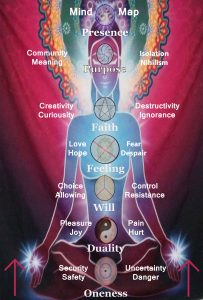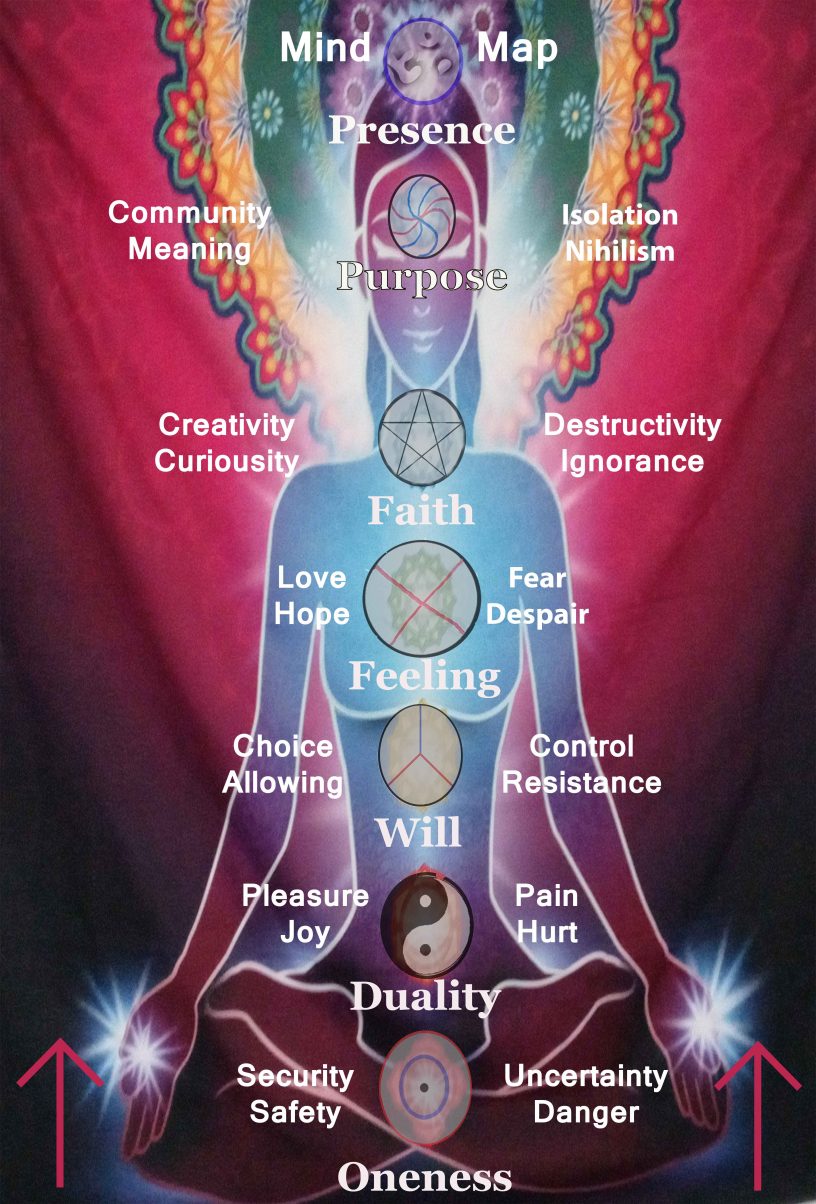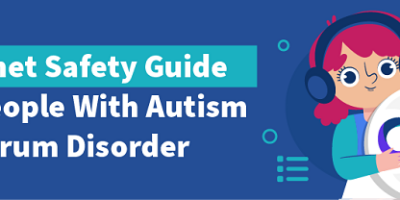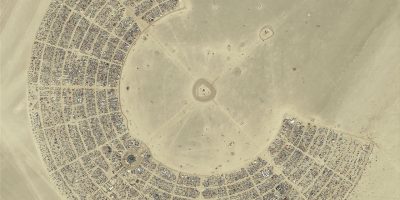I’m getting a better, clearer picture of what the mind looks like. There are facets to the mind, the facets are described as developmental phases of awareness. Each phase builds upon the next both including and expanding upon the previous facet. There is a process of growth at each facet, best described by Ken Wilber in his description of consciousness (https://en.wikipedia.org/wiki/Ken_Wilber#Books_by_Wilber). This process can go well or wrong and is one of the main sources of mental illness. The mind grows in complexity, purpose/use/awareness at each facet, and thus also expands the scope of potential and actual mental illness.
Now let’s have a look at the various facets. There are seven facets. I have a feeling (intuitive thought) that all 7, minus the last facet, are already there at birth. The names of each starting from the beginning of personal awareness are Unity, Duality, Will, Feeling, Faith, Purpose and Presence. I will now describe each mental/emotional faculty. Unity is a pre-lingual part of the mind. In a practical way it can be understood as the unconscious proper, because this part of the mind is basically inaccessible with language. Which is to say you can’t go into your personal memories and talk about your existence at this level of mind. There are no words here. This description is via human knowledge of infant awareness through research.
Each facet of the mind is an expression and experience of personal reality. In this time in one’s life, we are completely dependent upon our parents for survival, and this includes a sense of safety and security. When food, safety and comfort are absent there is an experience of danger and uncertainty. The child/infant does not and cannot distinguish between themselves and others. At this point in their awareness there is no self versus other, rather there is only an all-encompassing self. This is not a deep spiritual awareness of the unity of life. It is an ignorance of the concept of “other”. The child is completely engrossed in self to the complete neglect of others– there is only self! All things, people, sounds, experiences, sensations and feelings are understood as “me”. It’s not as though the child thinks that you are me, rather, looking out, there is only me.
The first awareness to develop in the mind is the reality of both safety and danger, or of security and uncertainty. These are visceral experiences. There is no language saying that sometimes I am in danger and sometimes I am in safety. There is a direct feeling of both of these bodily experiences. The infant feels comforted in the arms of mom or dad; or just as real, feels the hurt of neglect, pain and unmet needs. This is the infant’s mental/emotional reality. Life is understood as both safe and dangerous. When this is understood by the personal mind, the budding self begins to grow towards and expands into the next facet.
The next facet I named Duality and is the beginning of awareness of the existence of more than me; now the child accepts or perceives that there is me and there is you. Language begins here too. The initial expressions of language are of feelings. The developing self perceives that vocalizations are mostly about feelings. Also, that their feelings of both pleasure and pain can be expressed and understood with specific words and sounds. The reality that there are two distinct experiences in pleasure and pain is accepted in this facet, or some variation of this awareness, depending upon the self’s actual experiences and environments. As the concept of “other” is strengthened through experience, the perceptions of other peoples’ will increases. This is seen in the actual choices others make in satisfying the newly discovered self’s needs. The child learns that their needs are not actually the same as their caregivers needs. They seem to want different things than me, and the next facet of mind begins to be explored.
I called this facet Will. Here the child –with growing language skills– begins to experience choice and allowing. On the other end of the duality spectrum, control or resistant is also felt, through their parents. The natural ability to mirror and copy the behaviours of the people we love becomes clear here. The child will start to learn from and practice what their parents show them. Will is not actually practised at the beginning of this stage, rather will is mimicked. Soon though, especially if the child does not sense their own will being heard, the child will start to express their will in louder and stronger ways. In an attempt to be heard and get what they want, the child begins to exert their will, and this battle of wills between adults and child shapes the newly forming self.
The interplay between environment, which includes people, setting and more, with the newly forming mind becomes more prominent in this facet of mind, and continues to become more complex as the mind grows in awareness and complexity. This growth in will changes the way personal feelings are experienced. We become aware that we can also choose our feelings. Then the growing child enters the next facet of mind.
Although feelings have always been a part of the growing human, it is not until we develop our personal will that we start to have the ability to control our feelings. This facet, named Feelings, demonstrates that each facet of the mind has always been present. What I am describing here is the activation of the facet through personal attention and struggle with that aspect of mind. Only after the child discovers their ability to choose and want, or not want, can the control of feelings be experienced.
The struggle being experienced in this facet seems complicated, the self begins to want specific feelings like happy, sad, angry, calm etc. This attempt to control actual feelings is very hard, and many never grow to understand the fact that we can’t control our feelings. The discovery in this facet is not how to control feelings, but the choice to interpret experience through love or fear. Love will produce a certain set of feelings, while fear will create a different set of feelings. We begin the lifelong journey of learning, or not, to interpret our experiences through love and/or fear. The illusion here is that we choose our feelings, and the reality is that we can only choose how we respond to experience with love over fear.
Fear is the default choice and has been the dominant energy in our lives up to this point. If the family we are growing up in has been living in love, then this change will be easier to make. If though the predominant interpretation of life has been through fear, then this will continue, as it is the natural response to life. Love is a higher choice, it comes from revelation, insight and faith. Which brings us easily into the next facet of mind the young teenager develops.
By now the developing human has many experiences and a good grasp of their native language. Their sense of self is almost fully developed. All along a system of beliefs have been presented through the family and community. Now the growing mind starts to fashion their own beliefs or rejects/accepts those beliefs taught by their family. In this facet of the mind, named Faith, the personal struggle is with finding a personal belief system or not. Here the mind discovers creativity and curiosity but can also become stuck in ignorance and destructive behaviours.
Again, these attributes have always been there, but now the self is aware of their inner conflict with family-based beliefs and culture, norms and traditional faiths. The complex interplay between the self and environment is brought to our attention. Creativity is easily stifled, and curiosity is unintentionally discouraged by both peers and authorities. As well the rebellious nature of this time in life leads many into destructive behaviour and ignorance through cleaving to the norm.
Another thing to note is that at this level of development there is no guarantee that the individual will continue to grow, or that they will become aware of this inner struggle. This means that the self remains at the stage of their Feelings, never overcoming the struggle of that facet and thus their attention stays in the realm of feelings. It is my opinion that most people do indeed remain in the lower facet of Feelings, never developing the skills or insights to overcome their inability to change how they interpret life. In this case, personal faith is not chosen, rather it is either received blindly I rejected fully. In either case Faith remains dormant.
Then, if one chooses, they can begin the final struggle in the mind’s development. Notice how each facet is manifest in a personal and inner struggle. In this facet, named by me Purpose, the individual wrestles with the meaning of their life. Questions about where they belong in society, what are our personal talents and gifts as well as their expressions are searched for. Through this inner struggle and personal search, the human feels either connected to their community and/or family or isolated and possibly useless and/or lonely.
Note how the best expressions of duality are a balanced experience. As I pondered the duality in this facet Purpose, I saw that the pain in this facet is the extremes, not one over the other, such as Feelings with its love/fear duality. Logic tells us that we want all love and no fear. Now looking at the self’s sense of purpose, I see that the ideal is a balance between these two expressions of purpose. Imagine a person who is feeling isolated, has no creative expressions and only goes out to work, surrounded by people but feeling alone. He is feeling some negative feelings. He feels sad, lonely, maybe useless. These are negative, painful feelings. Now look at the celebrity who feels trapped by being in the public eye, and talked about, presented or showing herself always to the personal loss of freedom, privacy, aloneness or downtime. She too will have negative painful thoughts and feelings. While, someone who has a family, a personal service to the community, and is practising their art –creativity is living a balanced life. This one will feel happy and connected to someone(s) and thing(s) and possibly think good of themselves. The simple, balanced life will grant people the greatest earthly rewards. The final facet of mind intrinsically teaches those who get here and solve its riddle balance and satisfaction in life. From here people may or will begin the final development in human consciousness.
These facets of mind that I have presented are descriptions in a detailed, clear (verbal) way, allowing for greater knowledge and understanding of both The Mind and your mind. In the final facet of mind, like the top facet of a well-cut diamond, this top facet touches subtly most of the other facets directly and all indirectly. This shining facet brings to mind it’s true and whole expression, which I am calling Presence. Here the individual does not struggle with anything, except the tendency to forget slipping back into one of the other facets of mind that the self no longer identifies with. This final stage of development brings the mind into a state of acceptance and awareness that love is transformed into compassion for my being and yours. Now we realize that the mind and body are one, our existence as a personal expression of mind is made possible in this body. The Mind –consciousness, which I am connected with, is in nature the same as my mind, which I identify as self. Presence allows awareness of self to include the infinite and the eternal; this brings on the realization that matter is to my body, as consciousness is to my mind. I am a part of the infinite, and eternal reality that makes up both the physical and psychic dimensions. This body and mind are united with all things both physically and mentally. Consciousness is therefore both material and psychic. Human awareness grows and expands to ultimately realize its true nature, which is more than both personal and collective, it is consciousness.
Describing this facet is enigmatic. Our language becomes subtle, touching upon the co-expression of both the personal and collective. Others see this being as peaceful, wise, loving, gentle, passionate, clear and centred. They are radical, unusual, often misunderstood as rebellious and weird, maybe a troublemaker. They feel competent, certain, grounded, open and receptive, but consistent and steadfast. These people are not living their lives anymore, they are driven to live fully the personal existence being given here and now.

Diagram 1. A physical representation of the multifaceted personal mind, with Presence at the top, a round shining surface of your mind. (https://i.ebayimg.com/images/i/371309396963-0-1/s-l1000.jpg)
Of course, the solid image of a mind is false, since the mind is not physical. Ken Wilber also has an excellent image of the mind, where he uses concentric rings, what he calls holons. Meaning wholes within other wholes creating a whole different than the original. These physical analogies are only useful to the degree that one remembers that the mind is not physical– it is not the brain.
The mind is a progression of perceptions shaped by the conscious reality of the personal mind. A self (ego) is created through the need for stability, simplicity and cohesion. The mind changes as awareness grows, as seen in the changing conscious experiences. I have found several distinct perceptions, or focus of attention, in the mind. In reality they are a fluid blending and flowing of consciousness, but the distinct facets allow for clear, concise knowledge of both the Mind and my mind. This knowledge will offer understanding, which can be used for healing and strengthening the mind through teaching and sharing this understanding.
I also believe that this new, rational, thought out mind map shows how non-physical things can be studied and known. Seen through the mind’s eye and researched using the scientific method blended with personal self-reflection and intuition, this mind map offers a novel understanding of the mind. How the mind looks, and how it grows and functions. Which implies that this presentation of mind allows for the curious and scientific exploration of how this knowledge affects mental health, emotional awareness and spiritual growth.

Third and final (?) edition of this word map.
Like what you read? Sign up for Chris’s monthly newsletter, the Wellness Cafe that explores the latest insights in psychology, spirituality, relationships and the journey of building an intentional community. Chris R. is a trans-personal psychology pioneer in mental health practices and alternative relationship coach. He lives and works in BC at the Wellness Cafe, a non-profit organization bringing high quality alternative mental health services to the public at affordable costs. Continue to conversation and find Chris on Telegram or Librti.com




